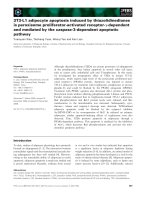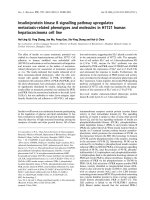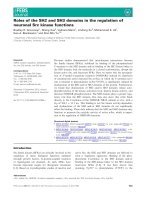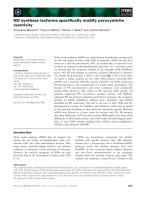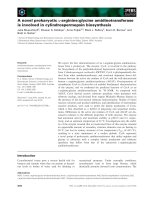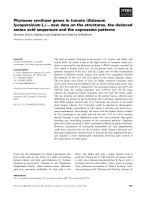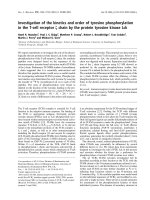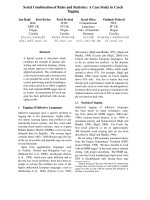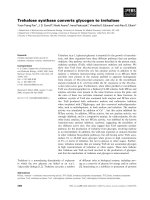Báo cáo khoa học: Glycogen synthase kinase 3b and b-catenin pathway is involved in toll-like receptor 4-mediated NADPH oxidase 1 expression in macrophages ppt
Bạn đang xem bản rút gọn của tài liệu. Xem và tải ngay bản đầy đủ của tài liệu tại đây (380.96 KB, 8 trang )
Glycogen synthase kinase 3b and b-catenin pathway is
involved in toll-like receptor 4-mediated NADPH oxidase 1
expression in macrophages
Jin-Sik Kim
1
*, Seungeun Yeo
1
*, Dong-Gu Shin
2
, Yoe-Sik Bae
3
, Jae-Jin Lee
4
, Byung-Rho Chin
4
,
Chu-Hee Lee
1
and Suk-Hwan Baek
1
1 Department of Biochemistry & Molecular Biology, Yeungnam University, Daegu, Korea
2 Department of Internal Medicine, Yeungnam University, Daegu, Korea
3 Department of Biochemistry, Dong-A University, Busan, Korea
4 Department of Dentistry, Yeungnam University, Daegu, Korea
Introduction
NADPH oxidase (Nox) is an essential enzyme in
phagocytes and generates reactive oxygen species
(ROS) for host defense [1]. Extensive evidence has now
shown that Nox is also one of the major sources of
ROS production in various nonphagocytic cells,
including smooth muscle cells and hepatocytes [2,3].
Members of the Nox family are transmembrane pro-
teins that catalyze the NADPH-dependent one-electron
reduction of oxygen to form superoxide [4]. To date,
seven members of this family have been described:
Nox1–5 and dual oxidase (Duox)-1 and -2. Among
these, the most studied is Nox2.
Nox1, the first-recognized homologue of Nox2 [5],
conserves the structural domain common to the cata-
lytic core of Nox2. Nox1-derived ROS were initially
reported to have tumorigenic and angiogenic functions
[6,7]. However, further studies suggest that Nox1 regu-
lates inflammation [8], atherosclerosis [9] and vascular
Keywords
glycogen synthase kinase 3b; NADPH
oxidase 1; reactive oxygen species; toll-like
receptor 4; b-catenin
Correspondence
Suk-Hwan Baek, Department of
Biochemistry & Molecular Biology, College
of Medicine, Yeungnam University, 317-1
Daemyung-5 Dong, Daegu 705-717, Korea
Fax: +82 53 623 8032
Tel: +82 53 620 4523
E-mail:
*These authors contributed equally to this
work
(Received 25 February 2010, revised 23
April 2010, accepted 27 April 2010)
doi:10.1111/j.1742-4658.2010.07700.x
Macrophage activation contributes to the pathogenesis of atherosclerosis.
In the vascular system, the major source of reactive oxygen species is the
NADPH oxidase (Nox) family. Nox1 is induced by lipopolysaccharide
(LPS) in macrophages, but the expression mechanism is not fully under-
stood. We found that LPS causes b-catenin accumulation by glycogen syn-
thase kinase 3b (GSK3b) inactivation, and that b-catenin accumulation
increases Nox1 expression. LPS induced Nox1 mRNA expression and reac-
tive oxygen species generation in Raw264.7 cells. Using bone marrow-
derived macrophages from toll-like receptor 4 mutant mice, we also tested
whether LPS-induced Nox1 expression is toll-like receptor 4 dependent.
LPS caused GSK3b phosphorylation, induced b-catenin accumulation and
increased nuclear translocation. The GSK3b inhibitor LiCl potentiated
LPS-induced Nox1 expression in accordance with b-catenin accumulation
and nuclear translocation. Conversely, ectopic expression of a constitutively
active GSK3b mutant severely attenuated Nox1 expression. These findings
identify a novel regulatory pathway controlling Nox1 expression by LPS-
stimulated macrophages.
Abbreviations
BMDMs, bone marrow-derived monocytes; DAPI, 4¢,6-diamidino-2-phenylindole; GSK3b, glycogen synthase kinase 3b; LPS, lipopolysaccharide;
M-CSF, macrophage colony-stimulating factor; Nox, NADPH oxidase; ROS, reactive oxygen species; TLR, toll-like receptor.
2830 FEBS Journal 277 (2010) 2830–2837 ª 2010 The Authors Journal compilation ª 2010 FEBS
tone [10]. It has been shown to regulate smooth muscle
cell growth, both hypertrophy and hyperplasia, and
migration [11]. In addition, Nox1 may be important in
regulating blood pressure [12]. Furthermore, Nox1
shows a relationship with toll-like receptor (TLR) in
controlling innate immunity. Kawahara et al. [13] have
shown that lipopolysaccharide (LPS) from pathogenic
Helicobacter pylori strains may potently stimulate ROS
production, mediated by Nox1, through a TLR4-
dependent pathway. Lee et al. [14] also reported that
the TLR9 agonist CpG ODN causes ROS production
via Nox1 gene expression in macrophages and contrib-
utes to foam cell formation. These studies suggest a
crucial role for Nox1 in TLR-mediated signaling path-
ways and its importance in innate immunity and
inflammatory responses.
The regulation of Nox1 seems to differ significantly
from that of Nox2, and the Nox1 regulatory mecha-
nism is still poorly defined. Full Nox1 activity is
known to need regulatory cofactors, including NoxO1,
NoxA1 and Rac1 [5]. The most well-studied activation
of Nox1 is that of angiotensin II mediating phospholi-
pase C and protein kinase C in vascular smooth mus-
cle cell. However, regulation of Nox1 activity by
mRNA induction is also important. Nox1 mRNA is
most highly expressed in colon epithelia [15], but is
also expressed at lower levels in macrophages [16].
Known Nox1-inducing factors are TLR agonists such
as angiotensin II, interferon-c and platelet-derived
growth factor [17–20]. However, research on the essen-
tial proteins involved in Nox1 gene inducement in
macrophages is not clear. There have been some
reports of the Nox1 expression mechanism in macro-
phages. Reports show that IRAK-1 increases Nox1
expression to produce ROS [21], and the increase in
Nox1-mediated ROS production is involved in macro-
phage differentiation into receptor activator of NF-j-B
ligand (RANKL)-induced osteoclasts [22]. Also, we
have previously reported that activation of c-Jun
NH
2
-terminal kinase (JNK) and cytosolic phospho-
lipase A
2
(cPLA
2
) by CpG ODN is essential in Nox1
mRNA expression and ROS generation in macrophag-
es [23]. Recently, we reported that calcium-independent
phospholipase A2b-mediated signaling regulates Nox1
expression in macrophages, and that the ROS pro-
duced are part of an important process controlling
foam cell formation [24].
Glycogen synthase kinase 3 (GSK3)b and the b-cate-
nin pathway are crucial regulators in the balance
between pro- and anti-inflammatory cytokine produc-
tion [25]. Recently, this pathway was shown to have
an essential role in inflammation and immune cells
[25]. In particular, many groups have shown that
GSK3b, through TLR signaling, is necessary in inflam-
mation. For example, it has been reported that GSK3b
regulates TLR-mediated cytokine production and inac-
tivation of GSK3b by LPS has a negative effect on
production of the pro-inflammatory cytokine inter-
feron-b [26]. b-Catenin is one of the most important
downstream molecules of the GSK3b pathway [27].
When b-catenin is released into the cytosol and is not
degraded by the proteosome, it may be translocated to
the nucleus and form a complex with T-cell factor.
The b-catenin ⁄ T-cell factor complex acts as a tran-
scriptional activator of many genes [28].
In this study, we show that GSK3b plays a funda-
mental role in regulating Nox1 gene expression. LPS
causes phosphorylation of GSK3b and accumulation
of b-catenin. Inhibition of GSK3b activity potently
augmented expression of the Nox1 gene in LPS-stimu-
lated macrophages, whereas ectopic expression of a
constitutively active GSK3b mutant reduced Nox1
gene expression. Taken together, these findings suggest
that GSK3b and the b-catenin pathway are critical reg-
ulators controlling Nox1 gene expression.
Results
Stimulation of macrophages with LPS induces
the expression of Nox1 via TLR4
We studied Nox1 expression and ROS formation by
TLR4 agonist LPS in Raw264.7 cells. As shown previ-
ously [24], LPS increased Nox1 mRNA expression in a
time-dependent manner (Fig. 1A) and induced ROS
formation (Fig. 1B). The TLR4 dependence of LPS-
induced Nox1 expression was confirmed using TLR4
mutant mice. Monocytes separated from the bone mar-
row of TLR4 wild-type (C3H ⁄ HeN) and TLR4 mutant
(C3H ⁄ HeJ) mice were differentiated into macrophages
by adding macrophage colony-stimulating factor
(M-CSF). We stimulated each bone marrow-derived
monocyte (BMDM), isolated from two types of mice,
with LPS, and compared the Nox1 mRNA expression
using RT-PCR. The effects of LPS were strong in the
BMDM of C3H ⁄ HeN, but relatively weak in the
BMDM of C3H ⁄ HeJ (Fig. 1C). The data suggest that
TLR4 is involved in LPS-induced Nox1 expression.
LPS phosphorylates GSK3b via TLR4 in
macrophages
LPS stimulation of innate immune cells has been shown
to promote GSK3b inactivation via phosphorylation of
serine 9 (S9) [26]. Therefore, we tested changes in
GSK3b phosphorylation, using LPS stimulation, in
J S. Kim et al. GSK3b-b-catenin is involved in Nox1 expression
FEBS Journal 277 (2010) 2830–2837 ª 2010 The Authors Journal compilation ª 2010 FEBS 2831
Raw264.7 cells. LPS stimulation induced GSK3b phos-
phorylation (Fig. 2A,B). To assess whether TLR4 is
required for LPS to induce GSK3b phosphorylation,
TLR4 wild-type and mutant macrophages were com-
pared for their abilities to phosphorylate GSK3b upon
LPS stimulation. GSK3b phosphorylation increased in
the wild-type, but was expressed relatively weakly in the
mutant type (Fig. 2C).
LPS induces b-catenin accumulation and nuclear
translocation
Because LPS induced phosphorylation of GSK3b,we
investigated whether b-catenin accumulation was
affected by LPS stimulation. LPS induced b-catenin
accumulation of macrophages and showed maximum
effects at 45 min with dose dependency (Fig. 3A,B).
To confirm the subcellular localization of b-catenin,
we fractionated cells by cytosol and nuclear fraction
after LPS stimulation. The time course of subcellular
localization for b-catenin showed a progressive
increase in the cytosolic fraction and a concomitant
significant increase in the nuclear fraction (Fig. 3C),
suggesting that b-catenin was translocated into the
nucleus. These results were also supported by fluores-
cent microscopy. In untreated cells, b-catenin was
mainly localized in the cytosol at a low level. After
45 min of treatment with LPS, the distribution of
b-catenin in the subcellular compartments was altered,
as shown by the nuclear translocation (Fig. 3D). This
shows that LPS is able to induce b-catenin accumula-
tion and subsequent translocation into the nucleus.
C
Nox1
-actin
0 0.5 1 2 4 6 0 0.5 1 2 4 6 LPS (h)
C3H/HeN (TLR4 WT)
C3H/HeJ (TLR4 Mut)
A
Nox1
β
β
β
-actin
0 1 2 3 4 6 LPS (h)
B
0
0.4
0.8
1.2
0 60 120 180 240 300
LPS Ti
me (min)
ROS production (RLU)
Con
LPS
Fig. 1. Induction of Nox1 mRNA and production of ROS by LPS in
macrophages. (A) Raw264.7 cells were stimulated with LPS
(100 ngÆmL
)1
) for the indicated times. Nox1 mRNA expression
was determined by RT-PCR and was normalized to b-actin. (B)
Raw264.7 cells were cultured in 96-well plates in a CO
2
incubator
for 1 h. The cells were changed to NaCl ⁄ P
i
containing lucigenin
(100 l
M) and NADPH (200 lM) and treated with LPS (100 ngÆmL
)1
)
for 300 min. Chemiluminescence was measured in relative light
units (RLU) every 10 min over a period of 300 min. (C) Primary
BMDMs were isolated from C3H ⁄ HeN (TLR4 wild-type)
or C3H ⁄ HeJ (TLR4 mutant) mice. BMDMs were differentiated for
5–7 days in media containing M-CSF and stimulated with LPS
(100 ngÆmL
)1
) for the indicated times. Nox1 mRNA expression was
determined by RT-PCR and was normalized to b-actin. The data are
representative of three independent experiments.
0 10 50 100 500 LPS (ng·mL
–1
)
pGSK3β
β
GSK3
β
B
A
pGSK3
β
GSK3
β
0 153045 60 LPS(min)
1 1.6 1.9 1.4 0.7 (fold)
C
pGSK3
β
GSK3
β
0 30 45 60 0 30 45 60 LPS (min)
HeN (TLR4 WT)
HeJ (TLR4 mut)
1 1.8 1.3 0.7 0.5 0.9 0.7 0.6 (fold)
Fig. 2. Inactivation of GSK3b by LPS in macrophages. (A,B)
Raw264.7 cells were incubated with LPS (100 ngÆmL
)1
) for
different times or doses. To assess phospho-GSK3b (S9), total cell
lysates were resolved on SDS ⁄ PAGE, immunoblotted with
anti-(phospho-GSK3b) or anti-GSK3b sera, and developed using
enhanced chemiluminescence. (C) Wild-type (C3H ⁄ HeN) and TLR4
mutant (C3H ⁄ HeJ) BMDMs were stimulated with LPS (100 ngÆmL
)1
)
for the indicated times. Phosphorylated GSK3b expression was
determined by western blot using anti-(phospho-GSK3b) serum
and was normalized to GSK3b expression. The data are represen-
tative of three independent experiments.
GSK3b-b-catenin is involved in Nox1 expression J S. Kim et al.
2832 FEBS Journal 277 (2010) 2830–2837 ª 2010 The Authors Journal compilation ª 2010 FEBS
GSK3b negatively controls Nox1 expression by
LPS-stimulated macrophages
Because LPS induced GSK3b phosphorylation and
b-catenin accumulation, we investigated whether this
pathway played a role in Nox1 gene expression. LiCl
is a well-known pharmacologic GSK3b inhibitor.
GSK3b-inactivated macrophages stimulated with LPS
produced significantly more b-catenin protein which
was also translocated more into the nucleus, than cells
stimulated with LPS alone (Fig. 4A,B). Also, Nox1
expression, using LPS plus LiCl, showed a greater
increase than LPS alone (Fig. 4C). The function of
GSK3b was confirmed in Nox1 expression using a
constitutively active GSK3b (S9A) mutant. Green
fluorescent protein-tagged GSK3b (S9A) mutant was
successfully overexpressed and the accumulation of
b-catenin and translocation to the nucleus by LPS
decreased more than in cells transfected with only the
vector (Fig. 4D–F). Taken together, these results dem-
onstrate that GSK3b plays a fundamental role in con-
trolling the expression of Nox1 by TLR4-stimulated
macrophages.
Discussion
ROS are known to act as a signaling molecule in vari-
ous physiological processes because of their regulated
production by ligands, the existence of catabolic
metabolism to terminate their signaling and their
redox-dependent reversible modification of target pro-
teins [29]. ROS are also considered important in mac-
rophage activation, because this process is significantly
related to the pathogenesis of inflammatory diseases
such as atherosclerosis or metabolic syndrome.
The ROS production system of macrophages is vari-
able and complicated, and Nox and its function have
become current issues. Seven types of Nox have been
found. The most studied is Nox2; however, other
types, especially Nox1 and Nox4, are also active areas
of research. ROS produced by Nox has a general
downstream physiological role. ROS produced by
Nox2 is required in the respiratory burst that occurs in
phagocytes [30]. It has been suggested that other types
of Nox are needed in host defense. For example, Nox1
is important in the colon and Duox-1 and -2 are
important in the lung [31]. Nox1 also contributes sig-
nificantly to gastrointestinal inflammation, hyperten-
sion and restenosis after angioplasty development
[8,18]. ROS production from Nox1 activity is primarily
controlled by p22phox and the Nox1 regulators
NoxA1 and NoxO1 [5], but an increase in Nox1 gene
expression is also essential. Angiotensin II and plate-
let-derived growth factor lead to increased Nox1
mRNA levels and contribute to vascular pathology
[18,20]. The TLR agonists LPS, flagellin and CpG
ODN have been shown to be Nox1 gene-inducing fac-
tors, leading to the verification of Nox1 function in
immune responses and the development of atheroscle-
rosis [17]. Therefore, the regulation of Nox1 mRNA
expression may be a potential therapeutic target for
C
β-catenin (short)
β
-catenin (long)
β
-tubulin
0 15 30 45 60 0 15 30 45 60 LPS (min)
Cytosol
Nucleus
D
DAPI FITC Merge
Con
LPS
B
0 10 50 100 500 LPS (ng·mL
–1
)
β
β
-catenin
β
-actin
A
0 15 30 45 60 LPS (min)
β
-catenin
β
-actin
Fig. 3. Changes in the subcellular localization of b-catenin induced
by LPS in macrophages. (A,B) Raw264.7 cells were incubated with
LPS (100 ngÆmL
)1
) for different times or doses. To assess b-catenin,
total cell lysates were resolved on SDS ⁄ PAGE, immunoblotted with
an anti-(b-catenin) serum and developed using enhanced chemilumi-
nescence. (C) Cells were treated with LPS (100 ngÆmL
)1
) for the
indicated times and fractionated into cytosolic and nuclear extracts.
Western blot on both extracts was determined by using anti-
(b-catenin) serum. b-Tubulin served as loading control and nuclear
marker. (D) Macrophages were treated with LPS (100 ngÆmL
)1
) for
40 min and stained with anti-b-catenin and DAPI at room tempera-
ture for 10 min. The cells were washed three times with NaCl ⁄ P
i
.
The images were acquired and analyzed using fluorescent micros-
copy. The data is representative of five independent experiments.
J S. Kim et al. GSK3b-b-catenin is involved in Nox1 expression
FEBS Journal 277 (2010) 2830–2837 ª 2010 The Authors Journal compilation ª 2010 FEBS 2833
these diseases. However, more research into the mecha-
nism controlling Nox1 mRNA expression is needed.
We previously reported that various types of TLR
agonists increase ROS production by inducing Nox1
mRNA expression, and the increased ROS convert
macrophages to foam cells by low-density lipoprotein
oxidation [14]. The aim of this study was to find the
signaling transduction molecule contributing to Nox1
mRNA expression by LPS. Our results showed that
GSK3b is a very important factor in b-catenin signal-
ing. In other words, LPS inactivates GSK3b through
phosphorylation, and the inactivated GSK3b inhibits
the degradation of b-catenin, promoting translocation
into the nucleus. It is hypothesized that the translocat-
ed b-catenin forms a complex with a specific transcrip-
tion factor, and thereby leads to an increase in Nox1
mRNA expression. Furthermore, experimental results,
using GSK3b inhibitor and constitutively active
GSK3b, have shown the importance of GSK3b in
Nox1 mRNA regulation.
Signaling molecules, such as protein kinase C-d
(PKC-d) and calcium-independent phospholipase A
2
(iPLA
2
b), are known to regulate Nox1 mRNA [24,32].
We previously reported that Akt also regulates Nox1
mRNA expression [24]. Therefore, we investigated the
correlation between Akt and GSk3b. The Akt inhibitor
LY294002 inhibited GSK3b phosphorylation by LPS
and also decreased Nox1 mRNA expression (Fig. S1).
These results suggest that LPS induces Akt phosphory-
lation and the activated Akt inactivates GSK3b,
thereby regulating Nox1 gene expression. However,
various signaling proteins that control Akt exist and it
is believed that more proteins may participate in the
process, showing the need for further research.
Consequently, LPS induces Nox1 expression via
TLR4. Phosphorylation of GSK3b by LPS inactivates
GSK3b and increases translocation of b-catenin to the
nucleus by inhibiting degradation. We suggest that
translocated b-catenin will activate specific transcrip-
tion factors and eventually increase Nox1 mRNA
C
– + – + LPS
–– ++LiCl
Nox1
-actin
B
Con
MergeFITCDAPI
LPS
LiCl
LPS
LiCl
A
–+–+LPS
––++LiCl
-catenin
-actin
D
-catenin
EGFP-
GSK3
GSK3
–+ –+ LPS
–+ –+ LPS
Vec
GSK3
S9A
F
-actin
Nox-1
Vec
GSK3
S9A
DAPI TRITC Merge
-
LPS
-
LPS
Vector
GSK3
S9A
E
Fig. 4. The effect of GSK3b on LPS-induced
b-catenin and Nox1 expression. (A–C)
Raw264.7 cells were stimulated with LPS
(100 ngÆmL
)1
) in the presence or absence of
the GSK3b inhibitor, LiCl (5 l
M). (A) The cell
lysates were analyzed for b-catenin using
western blotting. (B) Cells were fixed and
stained with anti-(b-catenin) serum and DAPI
and observed using fluorescent microscopy.
(C) Nox1 mRNA was analyzed by RT-PCR.
(D–F) Raw264.7 cells were transfected with
a pEGFP-C1 vector expressing a constitu-
tively active form (GSK3b S9A) or vector
alone. Gene-transfected cells were stimu-
lated with or without LPS (100 ngÆmL
)1
).
(D) Cell lysates were analyzed for GSK3b,
b-catenin by western blotting. (E) Cells were
fixed and stained with anti-(b-catenin) serum
and DAPI and observed with fluorescent
microscopy. (F) Nox1 mRNA was analyzed
by RT-PCR. The data are representative of
five independent experiments.
GSK3b-b-catenin is involved in Nox1 expression J S. Kim et al.
2834 FEBS Journal 277 (2010) 2830–2837 ª 2010 The Authors Journal compilation ª 2010 FEBS
expression. Our results showing the possibility of the
Nox1 gene being regulated by GSK3b ⁄ b-catenin are ori-
ginal and lead to the possibility that GSK3b ⁄ b-catenin
may contribute to the development of atherosclerosis.
Materials and methods
Reagents
Cell culture reagents, including fetal bovine serum, were
obtained from Life Technologies (Grand Island, NY,
USA). GSK3b, b-catenin and b-actin antibodies were from
Santa Cruz Biotechnology (Santa Cruz, CA, USA) and
phospho-GSK3b, Akt, p-Akt antibodies were from Cell
Signaling Technology (Danvers, MA, USA). Escherichia coli
LPS (0111:B4, Cat. No: L3024, purified by ion-exchanged
chromatography and containing > 1% protein and RNA),
NADPH and lucigenin were from Sigma-Aldrich (St.
Louis, MO, USA), the RT-PCR kit was from Takara Bio
Inc (Otsu, Japan). TLR4 wild-type (C3H ⁄ HeN) and
mutant (C3H ⁄ HeJ) mice were purchased from Central Lab
Animal Inc (Seoul, Korea). 4¢,6-diamidino-2-phenylindole
(DAPI) and Alexa fluor 488 goat anti-(rabbit IgG) were
from Invitrogen (Carlsbad, CA, USA). Rhodamine
(TRITC)-conjugated AffiniPure donkey anti-(rabbit IgG)
was from Jackson ImmunoResearch Laboratories Inc
(West Grove, PA, USA).
Plasmids and transfection
In order to make a GSK3b (S9A) plasmid construction,
cDNA from Raw264.7 cells was amplified by PCR with
mutation primer-1 (forward: 5¢-ACTCCACCCTTTTTCTC
CTC-3¢, reverse: 5¢-GCTCTCCGCAAAGGCGGTGGT-3¢)
and mutation primer-2 (forward: 5¢-CGACCGAGAACCA
CCGCCTTTGC-3¢, reverse: 5¢-CGCGTCGACCTCCTGG
GGGCTGTTCAG-3¢). Two PCR products were mixed and
amplified by cloning primer (forward: 5¢-CGCAGATCTA
TGTCGGGGCGACCGAGA-3¢, reverse: 5¢-CGCGTCGA
CCTCCTGGGGGCTGTTCAG-3¢) to obtain insert cDNA.
Insert cDNA was ligated with pEGFP-C1 vector (Invitrogen)
and the ligated vector was transformed into DH5a cells.
Nucleotide sequencing was performed after plasmid prepara-
tion. Cells were transfected with pEGFP-C1–GSK3b (S9A)
plasmid using Lipofectamine LTX reagent (Invitrogen)
according to the manufacturer’s protocol and then incubated
for 24 h before LPS stimulation.
Cell culture and mouse BMDM preparation
The Raw264.7 macrophage cell line was obtained from the
American Type Culture Collection (Manassas, VA, USA)
and cultured in Dulbecco’s modified Eagle’s medium
supplemented with 10% fetal bovine serum and 1% antibi-
otics (100 UÆmL
)1
penicillin and 100 lgÆmL
)1
streptomycin)
at 37 °Cin5%CO
2
. Primary BMDMs were isolated from
C3H ⁄ HeN or C3H ⁄ HeJ mice. BMDMs were differentiated
for 5–7 days in media containing M-CSF. The culture med-
ium consisted of Dulbecco’s modified Eagle’s medium sup-
plemented with 10% L929 cell-conditioned medium (as a
source of M-CSF). This study was conducted in accordance
with the guidelines for the care and use of laboratory ani-
mals provided by Yeungnam University and all experimen-
tal protocols were approved by the Ethics Committee of
Yeungnam University, South Korea.
Lucigenin assay
NADPH-dependent ROS generation was measured by
monitoring lucigenin-derived chemiluminescence at room
temperature using the Lmax II luminometer (Molecular
Devices, Sunnyvale, CA, USA). Briefly, cells were cultured
in 96-well plates, pretreated with LiCl for 1 h, subsequently
suspended in NaCl ⁄ P
i
and incubated with lucigenin
(100 lm) and NADPH (200 lm). LPS was added exoge-
nously to the suspended cells. Chemiluminescence was mea-
sured in relative light units every 10 min over a period of
200–300 min.
Fluorescent microscopy assay
Cells were plated in 24-well plates containing embedded
glass cover slips and pretreated with LiCl for 1 h before
stimulation by 100 ngÆmL
)1
LPS for 40 min. Cells were
fixed and stained with anti-b-catenin serum and DAPI and
observed using fluorescent microscopy. Fluorescent micros-
copy images were acquired and analyzed using an Olympus
BX51 fluorescent microscope and DP Manager Software
(Olympus, Japan).
Cytosolic and nuclear fractionation
Cells were plated in a 100 mm diameter dish and pretreated
with LiCl for 1 h before stimulation with 100 ngÆmL
)1
LPS
for the indicated times. Cytosolic and nuclear fractionation
was performed with NE-PER Nuclear and Cytoplasmic
Extraction Reagents (Pierce, Rockford, IL, USA) according
to manufacturer’s protocol.
RT-PCR
Total RNA was extracted from cells using Trizol reagent
(Invitrogen). One microgram of total RNA was used as a
template to make first-strand cDNA by oligo(dT) priming
using a commercial reverse transcriptase system (Promega,
Madison, WI, USA). The synthetic gene-specific primer sets
used for PCR were Nox1 forward primer, 5¢-AAGTGGCT
GTACTGGTTGG-3¢, and reverse primer, 5¢-GTGAGGA
J S. Kim et al. GSK3b-b-catenin is involved in Nox1 expression
FEBS Journal 277 (2010) 2830–2837 ª 2010 The Authors Journal compilation ª 2010 FEBS 2835
AGAGTCGGTAGTT-3¢, which amplified 238 bp of mouse
Nox1 cDNA, and b-actin forward primer, 5¢-TCCTTCGT
TGCCGGTCCACA-3¢, and reverse primer, 5¢-CGTCTCC
GGAGTCCATCACA-3¢, which amplified 509 bp of mouse
b-actin cDNA. Cycling conditions were 95 °C for 5 min,
followed by 28 cycles of 95 °C for 1 min, 57 °C for 1 min
and 72 °C for 1 min. For quantification, target genes were
normalized against b-actin.
Western blot analysis
Macrophages were cultured in six-well plates and treated
with LPS in the presence or absence of an inhibitor. Cell
pellets were resuspended in lysis buffer (50 mm Tris ⁄ HCl,
pH 8.0, 5 mm EDTA, 150 mm NaCl, 0.5% Nonidet P-40,
1mm phenylmethanesulfonyl fluoride, and protease inhibi-
tor cocktail). Proteins were separated by 8% reducing
SDS ⁄ PAGE and immunoblotted onto nitrocellulose mem-
branes in 20% methanol, 25 mm Tris and 192 mm glycine.
Membranes were then blocked with 5% non-fat dry milk
and incubated with primary antibody overnight. The mem-
branes were washed, incubated for 1 h with a secondary
antibody conjugated to horseradish peroxidase, rewashed
and developed using an enhanced chemiluminescence sys-
tem (GE Healthcare, Chalfont St Giles, UK).
Acknowledgement
This work was supported by the Korean Science and
Engineering Foundation via the Aging-associated Vas-
cular Disease Research Center at Yeungnam University
(R13-2005-005-02001-0).
References
1 Takeya R & Sumimoto H (2003) Molecular mechanism
for activation of superoxide-producing NADPH oxidas-
es. Mol Cell 16, 271–277.
2 Sturrock A, Cahill B, Norman K, Huecksteadt TP, Hill
K, Sanders K, Karwande SV, Stringham JC, Bull DA,
Gleich M et al. (2006) Transforming growth factor-
beta1 induces Nox4 NAD(P)H oxidase and reactive
oxygen species-dependent proliferation in human pul-
monary artery smooth muscle cells. Am J Physiol Lung
Cell Mol Physiol 290, L661–L673.
3 Reinehr R, Becker S, Eberle A, Grether-Beck S &
Haussinger D (2005) Involvement of NADPH oxidase
isoforms and Src family kinases in CD95-dependent
hepatocyte apoptosis. J Biol Chem 280, 27179–27194.
4 Nauseef WM (2008) Biological roles for the NOX family
NADPH oxidases. J Biol Chem 283, 16961–16965.
5 Sumimoto H (2008) Structure, regulation and evolution
of Nox-family NADPH oxidases that produce reactive
oxygen species. FEBS J 275, 3249–3277.
6 Arbiser JL, Petros J, Klafter R, Govindajaran B,
McLaughlin ER, Brown LF, Cohen C, Moses M,
Kilroy S, Arnold RS et al. (2002) Reactive oxygen
generated by Nox1 triggers the angiogenic switch. Proc
Natl Acad Sci USA 99, 715–720.
7 Suh YA, Arnold RS, Lassegue B, Shi J, Xu X, Sorescu
D, Chung AB, Griendling KK & Lambeth JD (1999)
Cell transformation by the superoxide-generating oxi-
dase Mox1. Nature 401, 79–82.
8 Rokutan K, Kawahara T, Kuwano Y, Tominaga K,
Sekiyama A & Teshima-Kondo S (2006) NADPH
oxidases in the gastrointestinal tract: a potential role of
Nox1 in innate immune response and carcinogenesis.
Antioxid Redox Signal 8, 1573–1582.
9 Ushio-Fukai M (2006) Redox signaling in angiogene-
sis: role of NADPH oxidase. Cardiovasc Res 71,
226–235.
10 Miller AA, Drummond GR & Sobey CG (2006) Novel
isoforms of NADPH-oxidase in cerebral vascular con-
trol. Pharmacol Ther 111, 928–948.
11 Csanyi G, Taylor WR & Pagano PJ (2009) NOX and
inflammation in the vascular adventitia. Free Radic Biol
Med 47, 1254–1266.
12 Gavazzi G, Banfi B, Deffert C, Fiette L, Schappi M,
Herrmann F & Krause KH (2006) Decreased blood
pressure in NOX1-deficient mice. FEBS Lett 580, 497–
504.
13 Kawahara T, Kohjima M, Kuwano Y, Mino H,
Teshima-Kondo S, Takeya R, Tsunawaki S, Wada A,
Sumimoto H & Rokutan K (2005) Helicobacter pylori
lipopolysaccharide activates Rac1 and transcription of
NADPH oxidase Nox1 and its organizer NOXO1 in
guinea pig gastric mucosal cells. Am J Physiol Cell
Physiol 288, C450–C457.
14 Lee JG, Lim EJ, Park DW, Lee SH, Kim JR & Baek
SH (2008) A combination of Lox-1 and Nox1 regulates
TLR9-mediated foam cell formation. Cell Signal 20,
2266–2275.
15 Kamizato M, Nishida K, Masuda K, Takeo K, Ya-
mamoto Y, Kawai T, Teshima-Kondo S, Tanahashi T
& Rokutan K (2009) Interleukin 10 inhibits interferon
gamma- and tumor necrosis factor alpha-stimulated
activation of NADPH oxidase 1 in human colonic epi-
thelial cells and the mouse colon. J Gastroenterol 44,
1172–1184.
16 Sorescu D, Weiss D, Lassegue B, Clempus RE, Szocs
K, Sorescu GP, Valppu L, Quinn MT, Lambeth JD,
Vega JD et al. (2002) Superoxide production and
expression of nox family proteins in human atheroscle-
rosis. Circulation
105, 1429–1435.
17 Maloney E, Sweet IR, Hockenbery DM, Pham M,
Rizzo NO, Tateya S, Handa P, Schwartz MW & Kim
F (2009) Activation of NF-kappaB by palmitate in
endothelial cells: a key role for NADPH oxidase-
GSK3b-b-catenin is involved in Nox1 expression J S. Kim et al.
2836 FEBS Journal 277 (2010) 2830–2837 ª 2010 The Authors Journal compilation ª 2010 FEBS
derived superoxide in response to TLR4 activation.
Arterioscler Thromb Vasc Biol 29, 1370–1375.
18 Dikalova A, Clempus R, Lassegue B, Cheng G, McCoy
J, Dikalov S, San Martin A, Lyle A, Weber DS, Weiss
D et al. (2005) Nox1 overexpression potentiates angio-
tensin II-induced hypertension and vascular smooth
muscle hypertrophy in transgenic mice. Circulation 112,
2668–2676.
19 Kuwano Y, Kawahara T, Yamamoto H, Teshima-
Kondo S, Tominaga K, Masuda K, Kishi K, Morita K
& Rokutan K (2006) Interferon-gamma activates tran-
scription of NADPH oxidase 1 gene and upregulates
production of superoxide anion by human large intesti-
nal epithelial cells. Am J Physiol Cell Physiol 290,
C433–C443.
20 Kreuzer J, Viedt C, Brandes RP, Seeger F, Rosenkranz
AS, Sauer H, Babich A, Nurnberg B, Kather H &
Krieger-Brauer HI (2003) Platelet-derived growth factor
activates production of reactive oxygen species by
NAD(P)H oxidase in smooth muscle cells through
Gi1,2. FASEB J 17, 38–40.
21 Maitra U, Singh N, Gan L, Ringwood L & Li L (2009)
IRAK-1 contributes to lipopolysaccharide-induced
reactive oxygen species generation in macrophages by
inducing NOX-1 transcription and Rac1 activation and
suppressing the expression of antioxidative enzymes.
J Biol Chem 284, 35403–35411.
22 Lee NK, Choi YG, Baik JY, Han SY, Jeong DW, Bae
YS, Kim N & Lee SY (2005) A crucial role for reactive
oxygen species in RANKL-induced osteoclast differenti-
ation. Blood 106, 852–859.
23 Lee JG, Lee SH, Park DW, Yoon HS, Chin BR, Kim
JH, Kim JR & Baek SH (2008) Toll-like recep-
tor 9-stimulated monocyte chemoattractant protein-1 is
mediated via JNK-cytosolic phospholipase A2-ROS
signaling. Cell Signal 20, 105–111.
24 Lee SH, Park DW, Park SC, Park YK, Hong SY, Kim
JR, Lee CH & Baek SH (2009) Calcium-independent
phospholipase A2beta-Akt signaling is involved in
lipopolysaccharide-induced NADPH oxidase 1 expres-
sion and foam cell formation. J Immunol 183, 7497–
7504.
25 Jope RS, Yuskaitis CJ & Beurel E (2007) Glycogen
synthase kinase-3 (GSK3): inflammation, diseases, and
therapeutics. Neurochem Res 32, 577–595.
26 Wang H, Garcia CA, Rehani K, Cekic C, Alard P,
Kinane DF, Mitchell T & Martin M (2008) IFN-beta
production by TLR4-stimulated innate immune cells is
negatively regulated by GSK3-beta. J Immunol 181,
6797–6802.
27 Clevers H (2006) Wnt ⁄ beta-catenin signaling in develop-
ment and disease. Cell 127, 469–480.
28 Jin T, George Fantus I & Sun J (2008) Wnt and beyond
Wnt: multiple mechanisms control the transcriptional
property of beta-catenin. Cell Signal 20, 1697–1704.
29 Lambeth JD (2004) NOX enzymes and the biology of
reactive oxygen. Nat Rev Immunol 4, 181–189.
30 Bedard K & Krause KH (2007) The NOX family of
ROS-generating NADPH oxidases: physiology and
pathophysiology. Physiol Rev 87, 245–313.
31 van der Vliet A (2008) NADPH oxidases in lung biol-
ogy and pathology: host defense enzymes, and more.
Free Radic Biol Med 44, 938–955.
32 Fan CY, Katsuyama M & Yabe-Nishimura C (2005)
PKCdelta mediates up-regulation of NOX1, a catalytic
subunit of NADPH oxidase, via transactivation of the
EGF receptor: possible involvement of PKCdelta in
vascular hypertrophy. Biochem J 390, 761–767.
Supporting information
The following supplementary material is available:
Fig. S1. The effect of Akt on LPS-induced GSK3b
inactivation and Nox1 expression.
This supplementary material can be found in the
online version of this article.
Please note: As a service to our authors and readers,
this journal provides supporting information supplied
by the authors. Such materials are peer-reviewed and
may be re-organized for online delivery, but are not
copy-edited or typeset. Technical support issues arising
from supporting information (other than missing files)
should be addressed to the authors.
J S. Kim et al. GSK3b-b-catenin is involved in Nox1 expression
FEBS Journal 277 (2010) 2830–2837 ª 2010 The Authors Journal compilation ª 2010 FEBS 2837
